Pertussis Vaccine Effectiveness and Challenges
VerifiedAdded on 2020/05/28
|8
|1764
|47
AI Summary
This assignment delves into the effectiveness and limitations of current pertussis vaccines. It examines factors contributing to waning immunity, the emergence of vaccine-resistant strains, and the complexities of achieving herd immunity. The analysis also considers potential solutions and future directions in pertussis vaccine research and public health interventions.
Contribute Materials
Your contribution can guide someone’s learning journey. Share your
documents today.
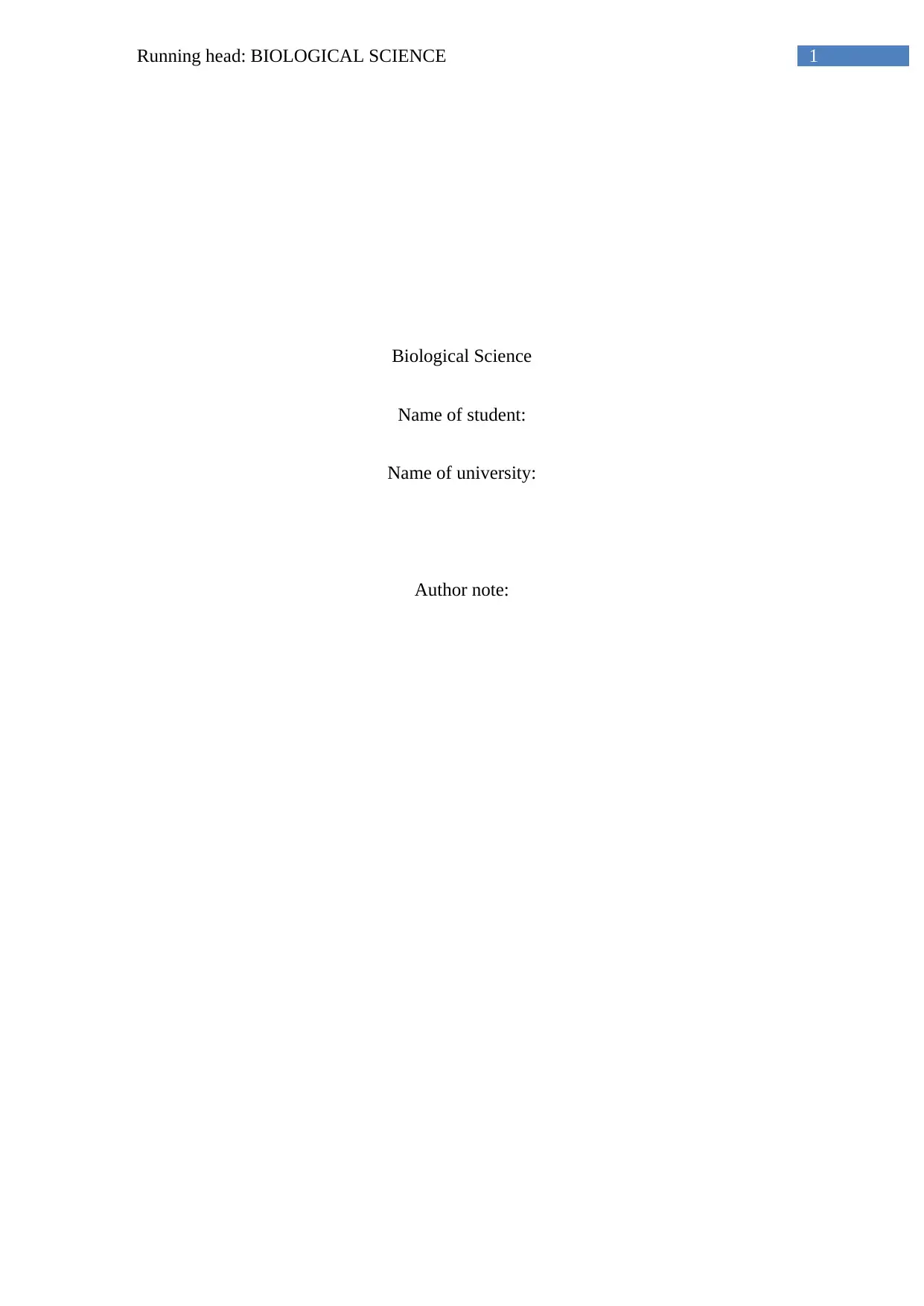
1Running head: BIOLOGICAL SCIENCE
Biological Science
Name of student:
Name of university:
Author note:
Biological Science
Name of student:
Name of university:
Author note:
Secure Best Marks with AI Grader
Need help grading? Try our AI Grader for instant feedback on your assignments.
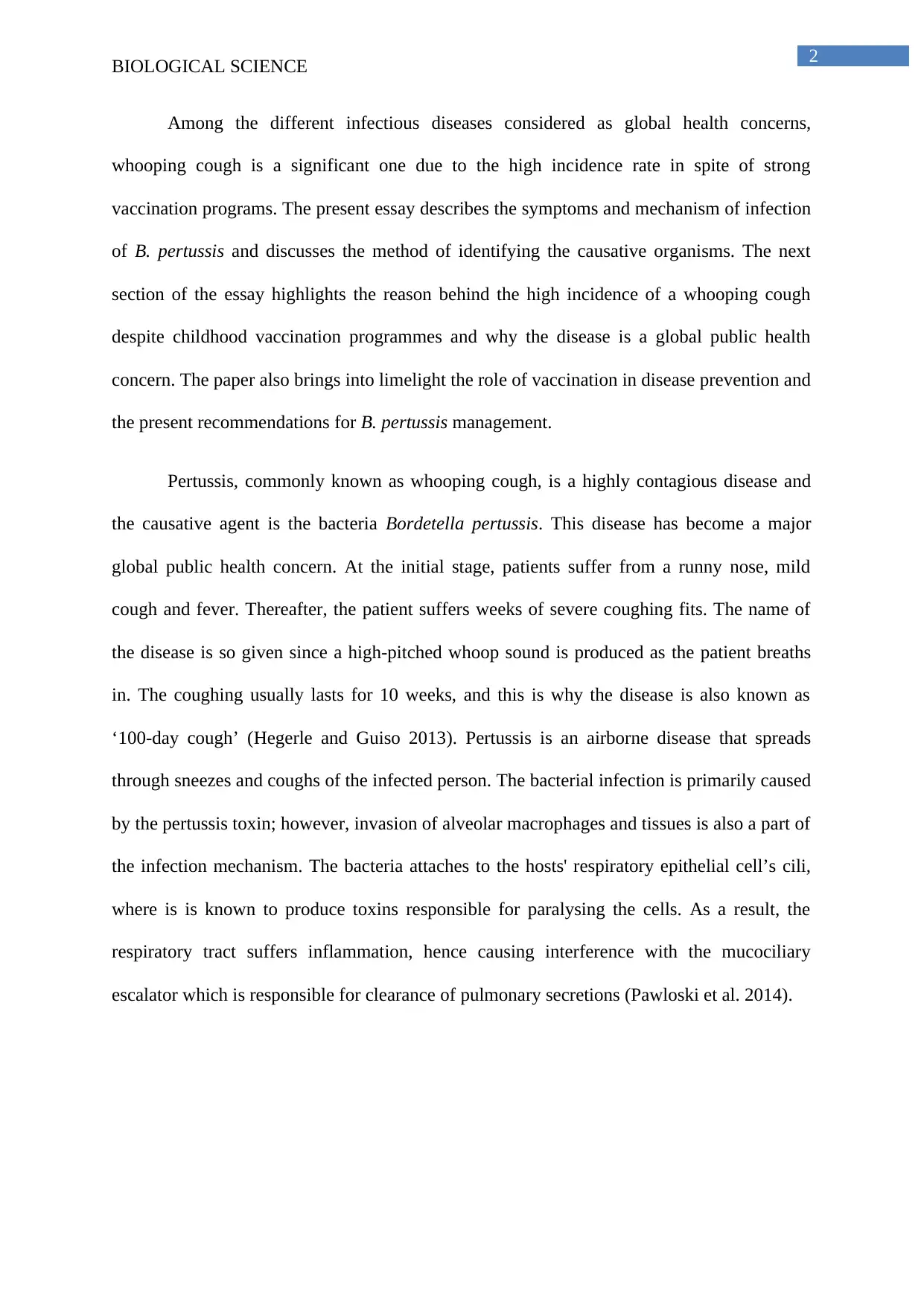
2
BIOLOGICAL SCIENCE
Among the different infectious diseases considered as global health concerns,
whooping cough is a significant one due to the high incidence rate in spite of strong
vaccination programs. The present essay describes the symptoms and mechanism of infection
of B. pertussis and discusses the method of identifying the causative organisms. The next
section of the essay highlights the reason behind the high incidence of a whooping cough
despite childhood vaccination programmes and why the disease is a global public health
concern. The paper also brings into limelight the role of vaccination in disease prevention and
the present recommendations for B. pertussis management.
Pertussis, commonly known as whooping cough, is a highly contagious disease and
the causative agent is the bacteria Bordetella pertussis. This disease has become a major
global public health concern. At the initial stage, patients suffer from a runny nose, mild
cough and fever. Thereafter, the patient suffers weeks of severe coughing fits. The name of
the disease is so given since a high-pitched whoop sound is produced as the patient breaths
in. The coughing usually lasts for 10 weeks, and this is why the disease is also known as
‘100-day cough’ (Hegerle and Guiso 2013). Pertussis is an airborne disease that spreads
through sneezes and coughs of the infected person. The bacterial infection is primarily caused
by the pertussis toxin; however, invasion of alveolar macrophages and tissues is also a part of
the infection mechanism. The bacteria attaches to the hosts' respiratory epithelial cell’s cili,
where is is known to produce toxins responsible for paralysing the cells. As a result, the
respiratory tract suffers inflammation, hence causing interference with the mucociliary
escalator which is responsible for clearance of pulmonary secretions (Pawloski et al. 2014).
BIOLOGICAL SCIENCE
Among the different infectious diseases considered as global health concerns,
whooping cough is a significant one due to the high incidence rate in spite of strong
vaccination programs. The present essay describes the symptoms and mechanism of infection
of B. pertussis and discusses the method of identifying the causative organisms. The next
section of the essay highlights the reason behind the high incidence of a whooping cough
despite childhood vaccination programmes and why the disease is a global public health
concern. The paper also brings into limelight the role of vaccination in disease prevention and
the present recommendations for B. pertussis management.
Pertussis, commonly known as whooping cough, is a highly contagious disease and
the causative agent is the bacteria Bordetella pertussis. This disease has become a major
global public health concern. At the initial stage, patients suffer from a runny nose, mild
cough and fever. Thereafter, the patient suffers weeks of severe coughing fits. The name of
the disease is so given since a high-pitched whoop sound is produced as the patient breaths
in. The coughing usually lasts for 10 weeks, and this is why the disease is also known as
‘100-day cough’ (Hegerle and Guiso 2013). Pertussis is an airborne disease that spreads
through sneezes and coughs of the infected person. The bacterial infection is primarily caused
by the pertussis toxin; however, invasion of alveolar macrophages and tissues is also a part of
the infection mechanism. The bacteria attaches to the hosts' respiratory epithelial cell’s cili,
where is is known to produce toxins responsible for paralysing the cells. As a result, the
respiratory tract suffers inflammation, hence causing interference with the mucociliary
escalator which is responsible for clearance of pulmonary secretions (Pawloski et al. 2014).
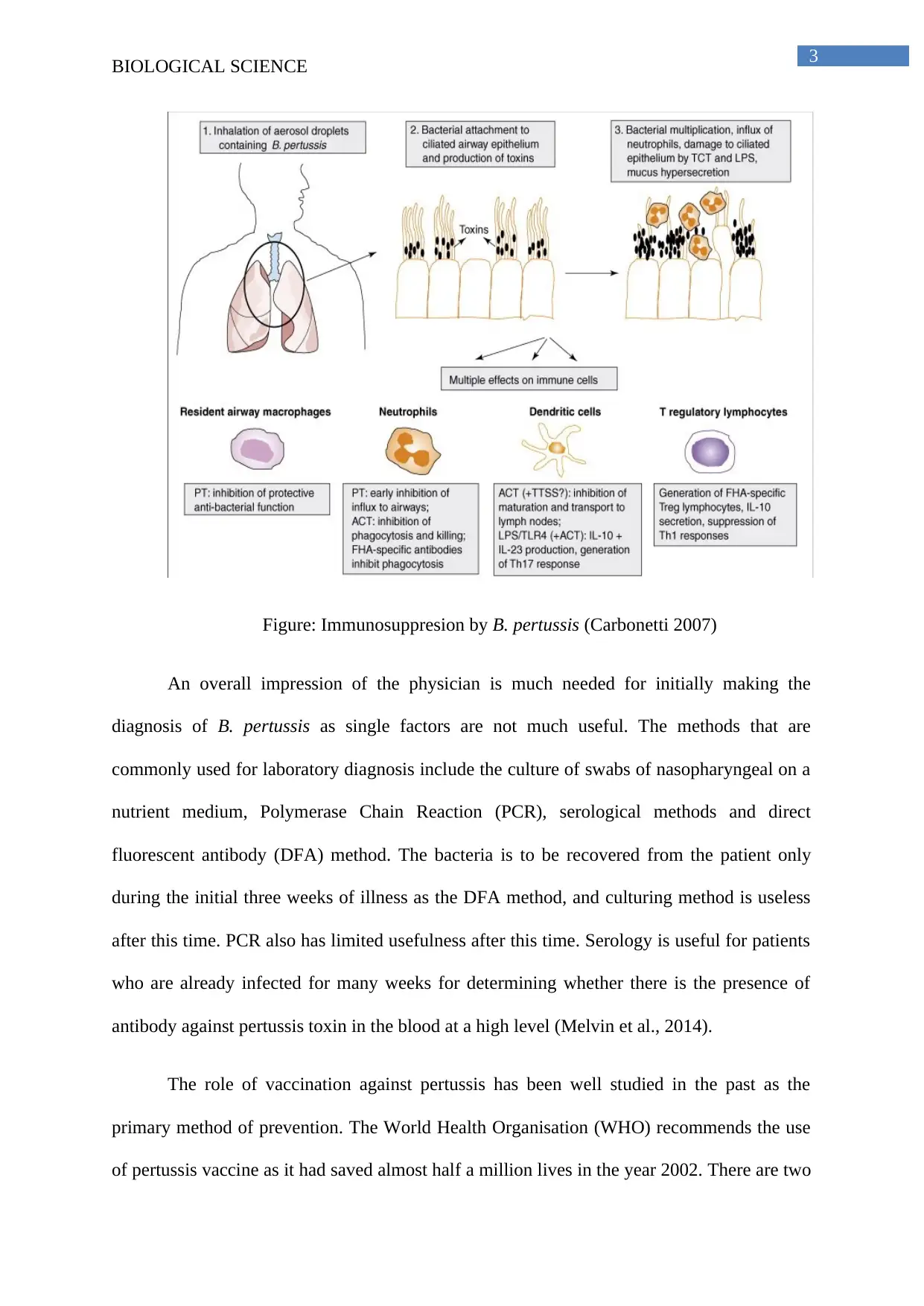
3
BIOLOGICAL SCIENCE
Figure: Immunosuppresion by B. pertussis (Carbonetti 2007)
An overall impression of the physician is much needed for initially making the
diagnosis of B. pertussis as single factors are not much useful. The methods that are
commonly used for laboratory diagnosis include the culture of swabs of nasopharyngeal on a
nutrient medium, Polymerase Chain Reaction (PCR), serological methods and direct
fluorescent antibody (DFA) method. The bacteria is to be recovered from the patient only
during the initial three weeks of illness as the DFA method, and culturing method is useless
after this time. PCR also has limited usefulness after this time. Serology is useful for patients
who are already infected for many weeks for determining whether there is the presence of
antibody against pertussis toxin in the blood at a high level (Melvin et al., 2014).
The role of vaccination against pertussis has been well studied in the past as the
primary method of prevention. The World Health Organisation (WHO) recommends the use
of pertussis vaccine as it had saved almost half a million lives in the year 2002. There are two
BIOLOGICAL SCIENCE
Figure: Immunosuppresion by B. pertussis (Carbonetti 2007)
An overall impression of the physician is much needed for initially making the
diagnosis of B. pertussis as single factors are not much useful. The methods that are
commonly used for laboratory diagnosis include the culture of swabs of nasopharyngeal on a
nutrient medium, Polymerase Chain Reaction (PCR), serological methods and direct
fluorescent antibody (DFA) method. The bacteria is to be recovered from the patient only
during the initial three weeks of illness as the DFA method, and culturing method is useless
after this time. PCR also has limited usefulness after this time. Serology is useful for patients
who are already infected for many weeks for determining whether there is the presence of
antibody against pertussis toxin in the blood at a high level (Melvin et al., 2014).
The role of vaccination against pertussis has been well studied in the past as the
primary method of prevention. The World Health Organisation (WHO) recommends the use
of pertussis vaccine as it had saved almost half a million lives in the year 2002. There are two
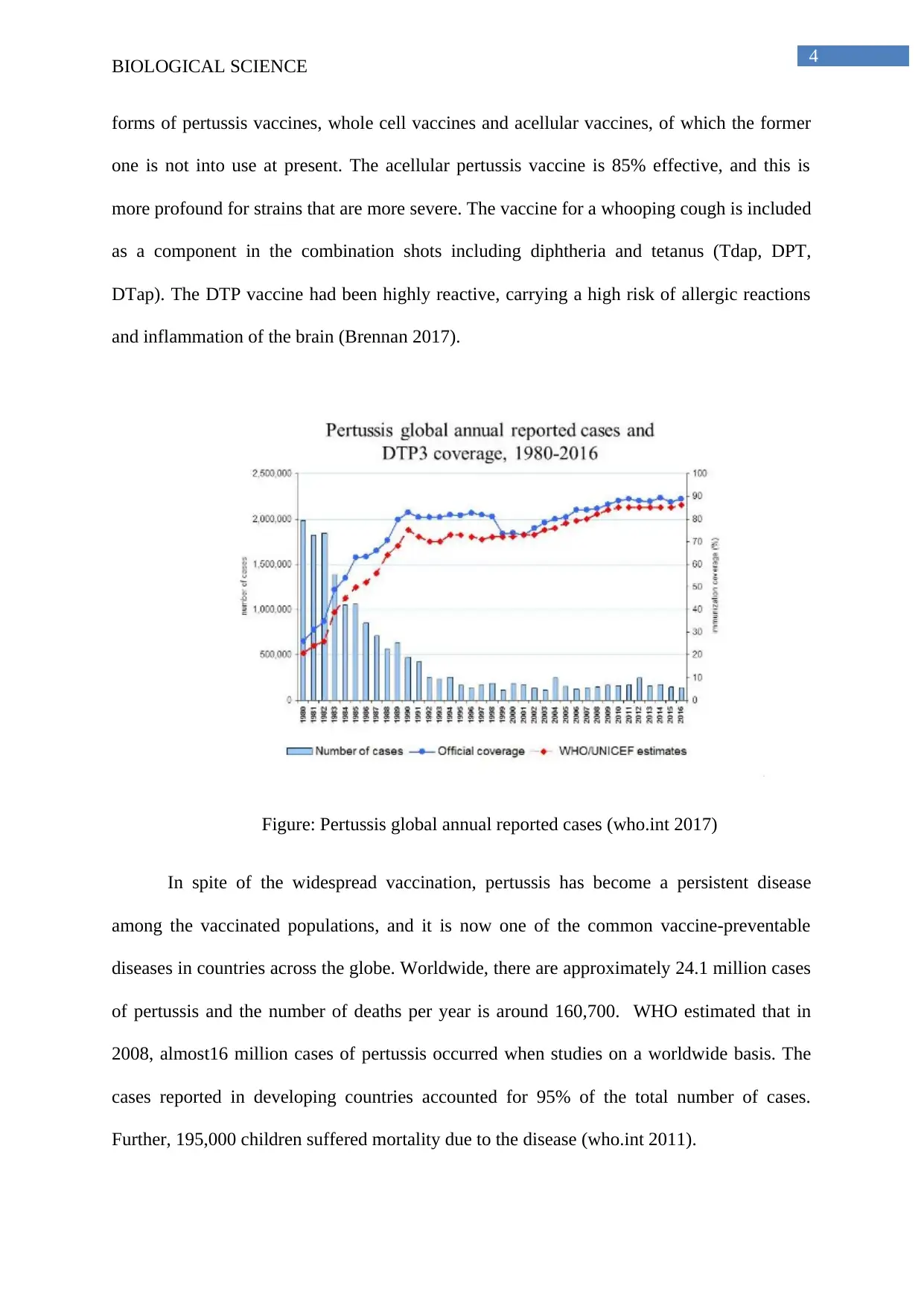
4
BIOLOGICAL SCIENCE
forms of pertussis vaccines, whole cell vaccines and acellular vaccines, of which the former
one is not into use at present. The acellular pertussis vaccine is 85% effective, and this is
more profound for strains that are more severe. The vaccine for a whooping cough is included
as a component in the combination shots including diphtheria and tetanus (Tdap, DPT,
DTap). The DTP vaccine had been highly reactive, carrying a high risk of allergic reactions
and inflammation of the brain (Brennan 2017).
Figure: Pertussis global annual reported cases (who.int 2017)
In spite of the widespread vaccination, pertussis has become a persistent disease
among the vaccinated populations, and it is now one of the common vaccine-preventable
diseases in countries across the globe. Worldwide, there are approximately 24.1 million cases
of pertussis and the number of deaths per year is around 160,700. WHO estimated that in
2008, almost16 million cases of pertussis occurred when studies on a worldwide basis. The
cases reported in developing countries accounted for 95% of the total number of cases.
Further, 195,000 children suffered mortality due to the disease (who.int 2011).
BIOLOGICAL SCIENCE
forms of pertussis vaccines, whole cell vaccines and acellular vaccines, of which the former
one is not into use at present. The acellular pertussis vaccine is 85% effective, and this is
more profound for strains that are more severe. The vaccine for a whooping cough is included
as a component in the combination shots including diphtheria and tetanus (Tdap, DPT,
DTap). The DTP vaccine had been highly reactive, carrying a high risk of allergic reactions
and inflammation of the brain (Brennan 2017).
Figure: Pertussis global annual reported cases (who.int 2017)
In spite of the widespread vaccination, pertussis has become a persistent disease
among the vaccinated populations, and it is now one of the common vaccine-preventable
diseases in countries across the globe. Worldwide, there are approximately 24.1 million cases
of pertussis and the number of deaths per year is around 160,700. WHO estimated that in
2008, almost16 million cases of pertussis occurred when studies on a worldwide basis. The
cases reported in developing countries accounted for 95% of the total number of cases.
Further, 195,000 children suffered mortality due to the disease (who.int 2011).
Secure Best Marks with AI Grader
Need help grading? Try our AI Grader for instant feedback on your assignments.
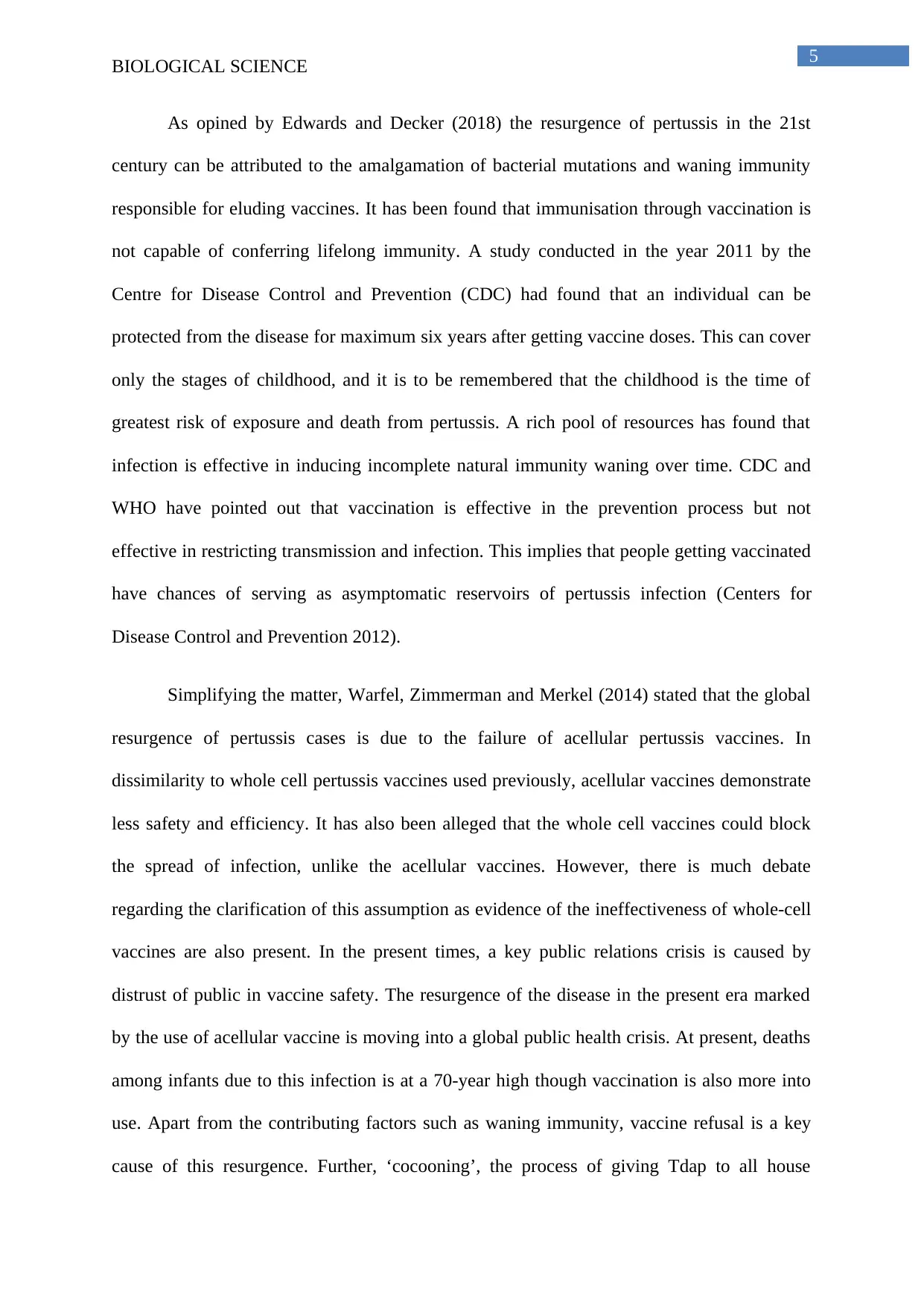
5
BIOLOGICAL SCIENCE
As opined by Edwards and Decker (2018) the resurgence of pertussis in the 21st
century can be attributed to the amalgamation of bacterial mutations and waning immunity
responsible for eluding vaccines. It has been found that immunisation through vaccination is
not capable of conferring lifelong immunity. A study conducted in the year 2011 by the
Centre for Disease Control and Prevention (CDC) had found that an individual can be
protected from the disease for maximum six years after getting vaccine doses. This can cover
only the stages of childhood, and it is to be remembered that the childhood is the time of
greatest risk of exposure and death from pertussis. A rich pool of resources has found that
infection is effective in inducing incomplete natural immunity waning over time. CDC and
WHO have pointed out that vaccination is effective in the prevention process but not
effective in restricting transmission and infection. This implies that people getting vaccinated
have chances of serving as asymptomatic reservoirs of pertussis infection (Centers for
Disease Control and Prevention 2012).
Simplifying the matter, Warfel, Zimmerman and Merkel (2014) stated that the global
resurgence of pertussis cases is due to the failure of acellular pertussis vaccines. In
dissimilarity to whole cell pertussis vaccines used previously, acellular vaccines demonstrate
less safety and efficiency. It has also been alleged that the whole cell vaccines could block
the spread of infection, unlike the acellular vaccines. However, there is much debate
regarding the clarification of this assumption as evidence of the ineffectiveness of whole-cell
vaccines are also present. In the present times, a key public relations crisis is caused by
distrust of public in vaccine safety. The resurgence of the disease in the present era marked
by the use of acellular vaccine is moving into a global public health crisis. At present, deaths
among infants due to this infection is at a 70-year high though vaccination is also more into
use. Apart from the contributing factors such as waning immunity, vaccine refusal is a key
cause of this resurgence. Further, ‘cocooning’, the process of giving Tdap to all house
BIOLOGICAL SCIENCE
As opined by Edwards and Decker (2018) the resurgence of pertussis in the 21st
century can be attributed to the amalgamation of bacterial mutations and waning immunity
responsible for eluding vaccines. It has been found that immunisation through vaccination is
not capable of conferring lifelong immunity. A study conducted in the year 2011 by the
Centre for Disease Control and Prevention (CDC) had found that an individual can be
protected from the disease for maximum six years after getting vaccine doses. This can cover
only the stages of childhood, and it is to be remembered that the childhood is the time of
greatest risk of exposure and death from pertussis. A rich pool of resources has found that
infection is effective in inducing incomplete natural immunity waning over time. CDC and
WHO have pointed out that vaccination is effective in the prevention process but not
effective in restricting transmission and infection. This implies that people getting vaccinated
have chances of serving as asymptomatic reservoirs of pertussis infection (Centers for
Disease Control and Prevention 2012).
Simplifying the matter, Warfel, Zimmerman and Merkel (2014) stated that the global
resurgence of pertussis cases is due to the failure of acellular pertussis vaccines. In
dissimilarity to whole cell pertussis vaccines used previously, acellular vaccines demonstrate
less safety and efficiency. It has also been alleged that the whole cell vaccines could block
the spread of infection, unlike the acellular vaccines. However, there is much debate
regarding the clarification of this assumption as evidence of the ineffectiveness of whole-cell
vaccines are also present. In the present times, a key public relations crisis is caused by
distrust of public in vaccine safety. The resurgence of the disease in the present era marked
by the use of acellular vaccine is moving into a global public health crisis. At present, deaths
among infants due to this infection is at a 70-year high though vaccination is also more into
use. Apart from the contributing factors such as waning immunity, vaccine refusal is a key
cause of this resurgence. Further, ‘cocooning’, the process of giving Tdap to all house
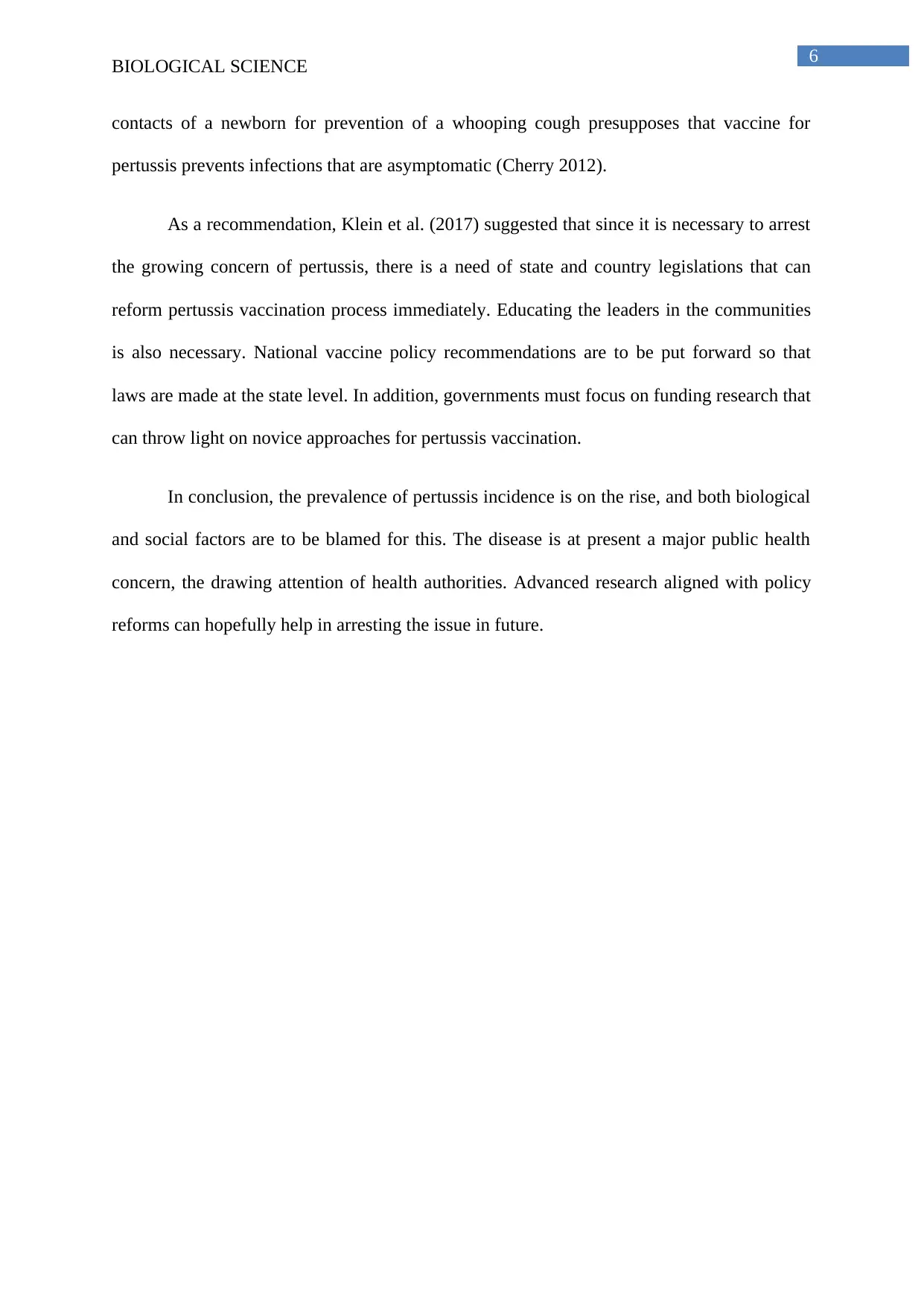
6
BIOLOGICAL SCIENCE
contacts of a newborn for prevention of a whooping cough presupposes that vaccine for
pertussis prevents infections that are asymptomatic (Cherry 2012).
As a recommendation, Klein et al. (2017) suggested that since it is necessary to arrest
the growing concern of pertussis, there is a need of state and country legislations that can
reform pertussis vaccination process immediately. Educating the leaders in the communities
is also necessary. National vaccine policy recommendations are to be put forward so that
laws are made at the state level. In addition, governments must focus on funding research that
can throw light on novice approaches for pertussis vaccination.
In conclusion, the prevalence of pertussis incidence is on the rise, and both biological
and social factors are to be blamed for this. The disease is at present a major public health
concern, the drawing attention of health authorities. Advanced research aligned with policy
reforms can hopefully help in arresting the issue in future.
BIOLOGICAL SCIENCE
contacts of a newborn for prevention of a whooping cough presupposes that vaccine for
pertussis prevents infections that are asymptomatic (Cherry 2012).
As a recommendation, Klein et al. (2017) suggested that since it is necessary to arrest
the growing concern of pertussis, there is a need of state and country legislations that can
reform pertussis vaccination process immediately. Educating the leaders in the communities
is also necessary. National vaccine policy recommendations are to be put forward so that
laws are made at the state level. In addition, governments must focus on funding research that
can throw light on novice approaches for pertussis vaccination.
In conclusion, the prevalence of pertussis incidence is on the rise, and both biological
and social factors are to be blamed for this. The disease is at present a major public health
concern, the drawing attention of health authorities. Advanced research aligned with policy
reforms can hopefully help in arresting the issue in future.
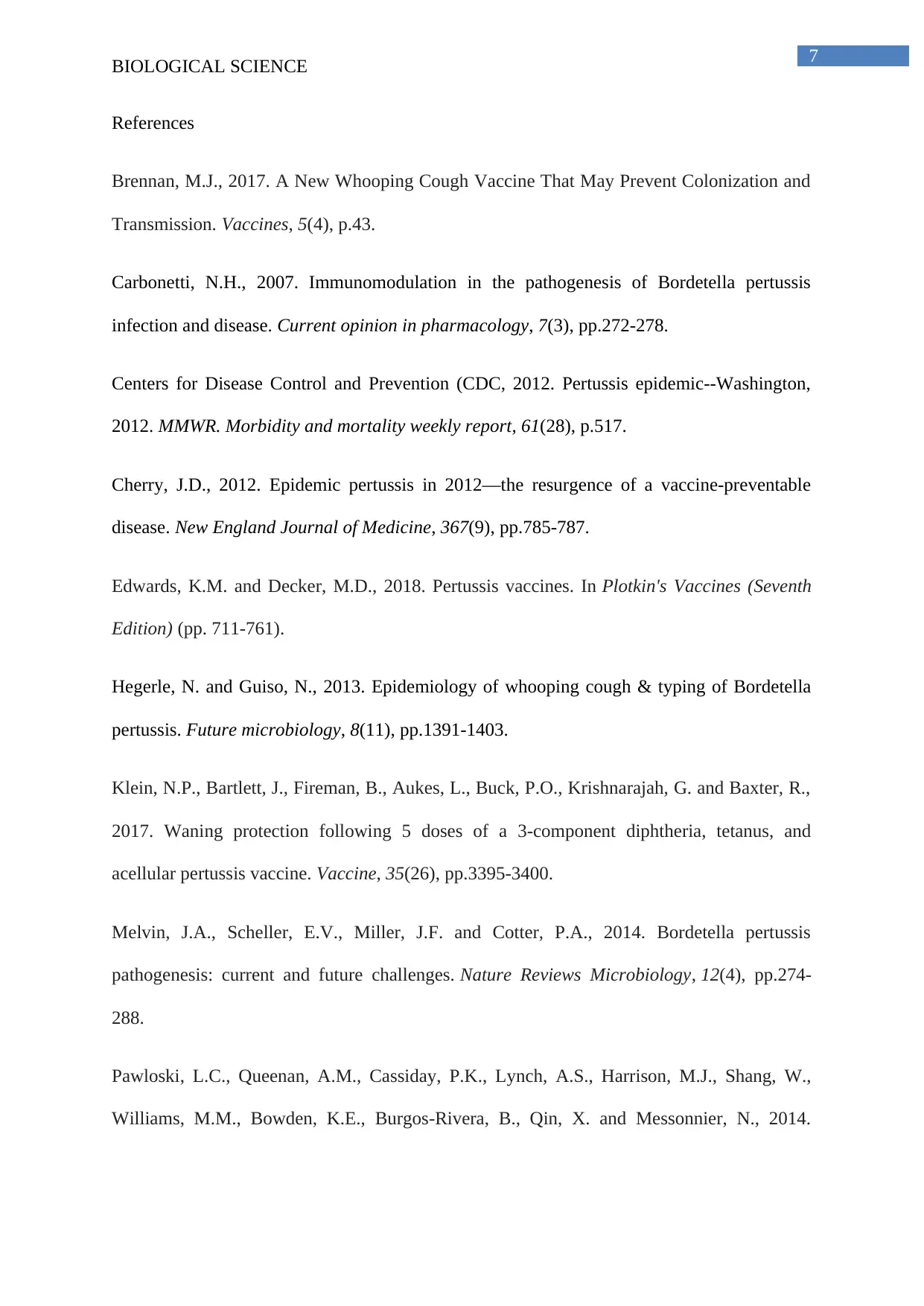
7
BIOLOGICAL SCIENCE
References
Brennan, M.J., 2017. A New Whooping Cough Vaccine That May Prevent Colonization and
Transmission. Vaccines, 5(4), p.43.
Carbonetti, N.H., 2007. Immunomodulation in the pathogenesis of Bordetella pertussis
infection and disease. Current opinion in pharmacology, 7(3), pp.272-278.
Centers for Disease Control and Prevention (CDC, 2012. Pertussis epidemic--Washington,
2012. MMWR. Morbidity and mortality weekly report, 61(28), p.517.
Cherry, J.D., 2012. Epidemic pertussis in 2012—the resurgence of a vaccine-preventable
disease. New England Journal of Medicine, 367(9), pp.785-787.
Edwards, K.M. and Decker, M.D., 2018. Pertussis vaccines. In Plotkin's Vaccines (Seventh
Edition) (pp. 711-761).
Hegerle, N. and Guiso, N., 2013. Epidemiology of whooping cough & typing of Bordetella
pertussis. Future microbiology, 8(11), pp.1391-1403.
Klein, N.P., Bartlett, J., Fireman, B., Aukes, L., Buck, P.O., Krishnarajah, G. and Baxter, R.,
2017. Waning protection following 5 doses of a 3-component diphtheria, tetanus, and
acellular pertussis vaccine. Vaccine, 35(26), pp.3395-3400.
Melvin, J.A., Scheller, E.V., Miller, J.F. and Cotter, P.A., 2014. Bordetella pertussis
pathogenesis: current and future challenges. Nature Reviews Microbiology, 12(4), pp.274-
288.
Pawloski, L.C., Queenan, A.M., Cassiday, P.K., Lynch, A.S., Harrison, M.J., Shang, W.,
Williams, M.M., Bowden, K.E., Burgos-Rivera, B., Qin, X. and Messonnier, N., 2014.
BIOLOGICAL SCIENCE
References
Brennan, M.J., 2017. A New Whooping Cough Vaccine That May Prevent Colonization and
Transmission. Vaccines, 5(4), p.43.
Carbonetti, N.H., 2007. Immunomodulation in the pathogenesis of Bordetella pertussis
infection and disease. Current opinion in pharmacology, 7(3), pp.272-278.
Centers for Disease Control and Prevention (CDC, 2012. Pertussis epidemic--Washington,
2012. MMWR. Morbidity and mortality weekly report, 61(28), p.517.
Cherry, J.D., 2012. Epidemic pertussis in 2012—the resurgence of a vaccine-preventable
disease. New England Journal of Medicine, 367(9), pp.785-787.
Edwards, K.M. and Decker, M.D., 2018. Pertussis vaccines. In Plotkin's Vaccines (Seventh
Edition) (pp. 711-761).
Hegerle, N. and Guiso, N., 2013. Epidemiology of whooping cough & typing of Bordetella
pertussis. Future microbiology, 8(11), pp.1391-1403.
Klein, N.P., Bartlett, J., Fireman, B., Aukes, L., Buck, P.O., Krishnarajah, G. and Baxter, R.,
2017. Waning protection following 5 doses of a 3-component diphtheria, tetanus, and
acellular pertussis vaccine. Vaccine, 35(26), pp.3395-3400.
Melvin, J.A., Scheller, E.V., Miller, J.F. and Cotter, P.A., 2014. Bordetella pertussis
pathogenesis: current and future challenges. Nature Reviews Microbiology, 12(4), pp.274-
288.
Pawloski, L.C., Queenan, A.M., Cassiday, P.K., Lynch, A.S., Harrison, M.J., Shang, W.,
Williams, M.M., Bowden, K.E., Burgos-Rivera, B., Qin, X. and Messonnier, N., 2014.
Paraphrase This Document
Need a fresh take? Get an instant paraphrase of this document with our AI Paraphraser
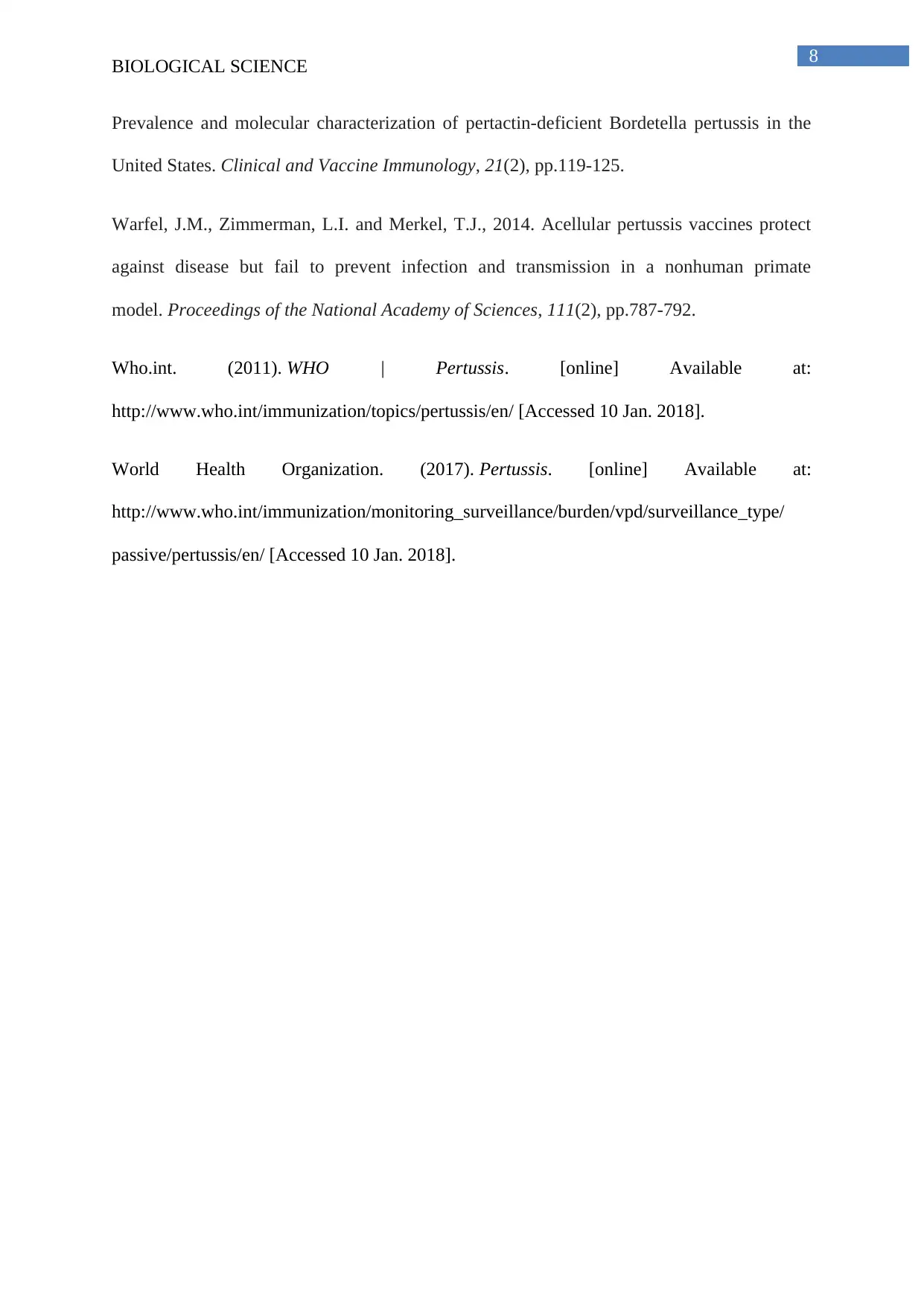
8
BIOLOGICAL SCIENCE
Prevalence and molecular characterization of pertactin-deficient Bordetella pertussis in the
United States. Clinical and Vaccine Immunology, 21(2), pp.119-125.
Warfel, J.M., Zimmerman, L.I. and Merkel, T.J., 2014. Acellular pertussis vaccines protect
against disease but fail to prevent infection and transmission in a nonhuman primate
model. Proceedings of the National Academy of Sciences, 111(2), pp.787-792.
Who.int. (2011). WHO | Pertussis. [online] Available at:
http://www.who.int/immunization/topics/pertussis/en/ [Accessed 10 Jan. 2018].
World Health Organization. (2017). Pertussis. [online] Available at:
http://www.who.int/immunization/monitoring_surveillance/burden/vpd/surveillance_type/
passive/pertussis/en/ [Accessed 10 Jan. 2018].
BIOLOGICAL SCIENCE
Prevalence and molecular characterization of pertactin-deficient Bordetella pertussis in the
United States. Clinical and Vaccine Immunology, 21(2), pp.119-125.
Warfel, J.M., Zimmerman, L.I. and Merkel, T.J., 2014. Acellular pertussis vaccines protect
against disease but fail to prevent infection and transmission in a nonhuman primate
model. Proceedings of the National Academy of Sciences, 111(2), pp.787-792.
Who.int. (2011). WHO | Pertussis. [online] Available at:
http://www.who.int/immunization/topics/pertussis/en/ [Accessed 10 Jan. 2018].
World Health Organization. (2017). Pertussis. [online] Available at:
http://www.who.int/immunization/monitoring_surveillance/burden/vpd/surveillance_type/
passive/pertussis/en/ [Accessed 10 Jan. 2018].
1 out of 8
Related Documents
Your All-in-One AI-Powered Toolkit for Academic Success.
+13062052269
info@desklib.com
Available 24*7 on WhatsApp / Email
![[object Object]](/_next/static/media/star-bottom.7253800d.svg)
Unlock your academic potential
© 2024 | Zucol Services PVT LTD | All rights reserved.





